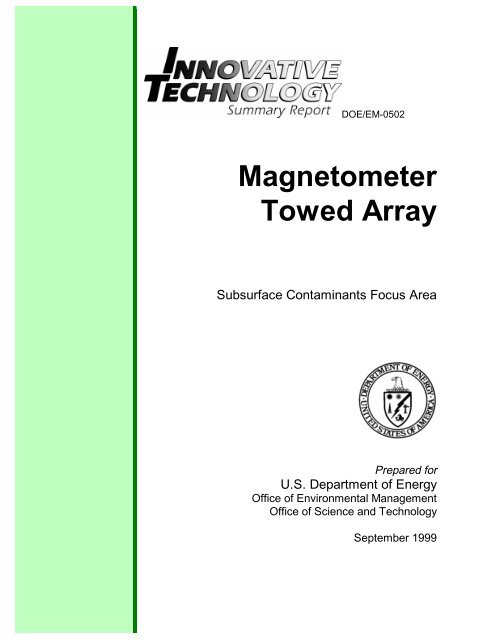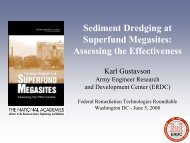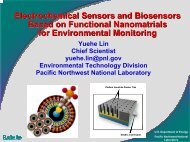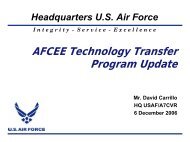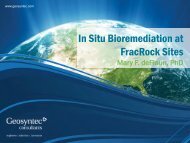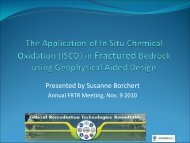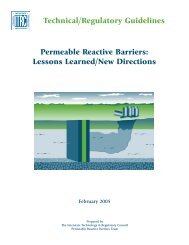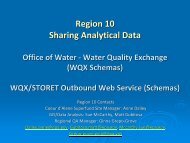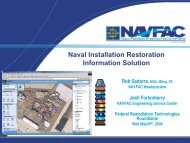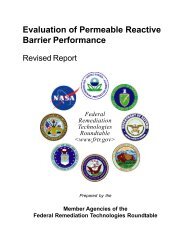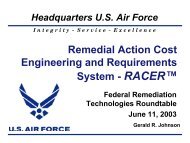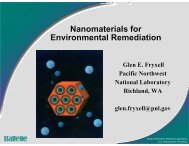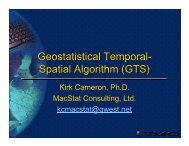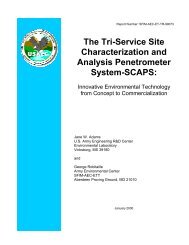Magnetometer Towed Array - Costperformance.org
Magnetometer Towed Array - Costperformance.org
Magnetometer Towed Array - Costperformance.org
Create successful ePaper yourself
Turn your PDF publications into a flip-book with our unique Google optimized e-Paper software.
DOE/EM-0502<br />
<strong>Magnetometer</strong><br />
<strong>Towed</strong> <strong>Array</strong><br />
Subsurface Contaminants Focus Area<br />
Prepared for<br />
U.S. Department of Energy<br />
Office of Environmental Management<br />
Office of Science and Technology<br />
September 1999
<strong>Magnetometer</strong><br />
<strong>Towed</strong> <strong>Array</strong><br />
OST/TMS ID 548<br />
Subsurface Contaminants Focus Area<br />
Demonstrated at<br />
Los Alamos National Laboratory<br />
Los Alamos, New Mexico<br />
and<br />
Kirtland Air Force Base<br />
Albuquerque, New Mexico
Purpose of this document<br />
Innovative Technology Summary Reports are designed to provide potential users with the<br />
information they need to quickly determine whether a technology would apply to a particular<br />
environmental management problem. They are also designed for readers who may<br />
recommend that a technology be considered by prospective users.<br />
Each report describes a technology, system, or process that has been developed and tested<br />
with funding from DOE’s Office of Science and Technology (OST). A report presents the full<br />
range of problems that a technology, system, or process will address and its advantages to the<br />
DOE cleanup in terms of system performance, cost, and cleanup effectiveness. Most reports<br />
include comparisons to baseline technologies as well as other competing technologies.<br />
Information about commercial availability and technology readiness for implementation is also<br />
included. Innovative Technology Summary Reports are intended to provide summary<br />
information. References for more detailed information are provided in an appendix.<br />
Efforts have been made to provide key data describing the performance, cost, and regulatory<br />
acceptance of the technology. If this information was not available at the time of publication,<br />
the omission is noted.<br />
All published Innovative Technology Summary Reports are available on the OST Web site at<br />
http://ost.em.doe.gov under “Publications.”<br />
iii
TABLE OF CONTENTS<br />
1. SUMMARY page 1<br />
2. TECHNOLOGY DESCRIPTION page 4<br />
3. PERFORMANCE page 8<br />
4. TECHNOLOGY APPLICABILITY AND ALTERNATIVES page 13<br />
5. COST page 15<br />
6. REGULATORY AND POLICY ISSUES page 19<br />
7. LESSONS LEARNED page 20<br />
APPENDICES<br />
A. REFERENCES page A-1<br />
iv
SECTION 1<br />
CONTENTS<br />
SUMMARY<br />
Technology Summary<br />
Problem<br />
The assessment of buried wastes requires collecting site-specific data to determine the location and level<br />
of contamination. These data can be obtained by using both intrusive and non-intrusive methods. While<br />
intrusive methods, such as boreholes, provide direct information about the subsurface, they can result in<br />
greater risks to on-site workers, may be slow, provide only point measurements, and are costly. Nonintrusive<br />
methods, such as magnetometers, provide information that can be used to infer subsurface<br />
conditions. These methods result in less risk to site workers, are typically rapid, can be used to measure<br />
larger areas, and are relatively inexpensive. They are excellent for Phase I screening of a site.<br />
How It Works<br />
• The <strong>Magnetometer</strong> <strong>Towed</strong> <strong>Array</strong> is a passive, non-intrusive, site-assessment method used to infer<br />
subsurface conditions at sites where buried waste are contained or encapsulated in ferromagnetic<br />
materials.<br />
• The <strong>Magnetometer</strong> <strong>Towed</strong> <strong>Array</strong> is designed to collect a high number of survey points with<br />
accurately referenced latitude and longitude over a large area in a short period of time with near<br />
real-time data interpretation.<br />
• The <strong>Magnetometer</strong> <strong>Towed</strong> <strong>Array</strong> is a vehicle-based system (see Figure 1) that measures the<br />
strength of the earth’s magnetic field while traveling at speeds of 5 to 15 miles per hour (mph).<br />
Figure 1. Photograph of the <strong>Magnetometer</strong> <strong>Towed</strong> <strong>Array</strong> vehicle<br />
⎯ Buried objects are identified by a change in the earth’s normal magnetic field. The earth’s<br />
magnetic field is measured by seven cesium vapor magnetometers that are mounted on a 10-<br />
ft-wide boom on the towed platform. Each magnetometer takes 20 measurements/second.<br />
This rate provides 70,000 measurements/acre (at 5 mph) or one measurement for every 1.5ft 2 .<br />
U. S. Department of Energy 1
⎯ The measurement data are then automatically processed by the system computers to provide<br />
high-resolution maps that show the latitude and longitude of buried ferrous objects.<br />
⎯ A differential global positioning system (DGPS) was integrated into the system to provide highaccuracy<br />
location control.<br />
Additionally, magnetic characteristics are collected and used to estimate the depth to and size of the<br />
objects detected.<br />
Potential Markets<br />
The <strong>Magnetometer</strong> <strong>Towed</strong> <strong>Array</strong> can be used at all buried waste sites where wastes were disposed in<br />
ferromagnetic materials. These sites could be owned by Department of Energy, Department of Defense,<br />
commercial sites, and others.<br />
Advantages Over Baseline<br />
• The <strong>Magnetometer</strong> <strong>Towed</strong> <strong>Array</strong> surveys 15 acres/day in contrast to 2 acres/day using a<br />
conventional magnetometer. The technology is more cost effective on a site larger than 50 acres<br />
when compared with conventional techniques on a 5-ft grid. When high-density sampling is<br />
necessary (less than 2-ft grid spacing), the <strong>Magnetometer</strong> <strong>Towed</strong> <strong>Array</strong> is more cost effective than<br />
conventional techniques at sites greater than 3 acres.<br />
• The high data-collection density allows better horizontal resolution and is more likely to identify<br />
buried ferrous objects. For example, the boundaries of burials cannot be estimated accurately<br />
using data collected on 10-ft centers.<br />
• A finer grid provides data redundancy; thus, a single erroneous data point can be recognized,<br />
whereas a survey on 5 of 10 centers may be impossible to recognize an erroneous data point.<br />
• Data collected on a fine grid can be quantitatively interpreted (size and location) using computer<br />
algorithms; such analysis is not meaningful when applied to conventional low-density data.<br />
Demonstration Summary<br />
• The <strong>Magnetometer</strong> <strong>Towed</strong> <strong>Array</strong>, also called the Surface <strong>Towed</strong> Ordnance Locator System<br />
(STOLS) was built by the U. S. Navy as a proof-of-principal, non-intrusive characterization<br />
system to locate and identify buried ordnance.<br />
• Under the U. S. Department of Energy (DOE) Mixed Waste Landfill Demonstration Program,<br />
Sandia National Laboratories (Sandia), in conjunction with the U. S. Naval Research Laboratory<br />
(NRL) and Geo-Centers, Inc., demonstrated and enhanced a commercially available system that<br />
was also suitable for use in characterization of DOE waste disposal sites. The development began<br />
in 1991; the relationship between Sandia and NRL ended in 1994.<br />
• The DOE/NRL team efforts focused on developing a more accurate and reliable global positioning<br />
system (GPS) and software enhancements that made the graphic display more versatile and user<br />
friendly. Concurrently, Geo-Centers, Inc. redesigned and built a commercially-viable tow vehicle<br />
and tow platform.<br />
• NRL has pursued further refinements in the magnetometer sensor technology and has worked to<br />
integrate other non-intrusive survey methods (such as ground-penetrating radar) into the towed<br />
vehicle-type system.<br />
• Sandia was responsible for managing the team that adapted the <strong>Magnetometer</strong> <strong>Towed</strong> <strong>Array</strong> for<br />
use at hazardous and radioactive waste sites and worked to select appropriate demonstration sites.<br />
Sandia National Laboratories’ Technical Area-2 (TA-2), Albuquerque, New Mexico served as the<br />
initial test site. Demonstrations also occurred at the Radioactive Burial-11 (RB-11) site at Kirtland<br />
Air Force Base, Albuquerque, New Mexico; TA-50 Material Disposal Area C at the Los Alamos<br />
National Laboratory, Los Alamos, New Mexico; and Technical Area-73 (TA-73) at the Los Alamos<br />
Airport landfill (TA-73 results are not presented in this document).<br />
2 U.S. Department of Energy
• NRL’s Chesapeake Beach Detachment, Chesapeake Beach, Maryland, site was used to test and<br />
select the new GPS that replaced the microwave-based GPS that was deficient during early survey<br />
work at TA-2. As a result of the NRL support to the project, a Trimble Navigation 4000 SSE DGPS<br />
was selected and integrated into the <strong>Magnetometer</strong> <strong>Towed</strong> <strong>Array</strong>; it is capable of accuracy within a<br />
meter while traveling at 5 mph.<br />
• The <strong>Magnetometer</strong> <strong>Towed</strong> <strong>Array</strong> demonstrations were successful. The objectives for the site<br />
surveys were met. The surveys provide high-quality magnetic maps of the surveyed areas. In<br />
addition, magnetic data characteristic of anomalous objects were used to draw conclusions<br />
concerning size and depth of burial sites.<br />
• The <strong>Magnetometer</strong> <strong>Towed</strong> <strong>Array</strong> is marketed by Geo-Centers, Inc., as the STOLS Search<br />
Technologies, Inc. (STI). Services are sold primarily to the Department of Defense.<br />
Contacts<br />
Technical<br />
Richard J. Russell, Director, Product Development, Geo-Centers, Inc. (617) 964-7070,<br />
E-mail rrussell@tech.geo-centers.com<br />
John R. Cochran, Principal Investigator, Sandia National Laboratories, (505) 844-5256<br />
Jim R. McDonald, Program Manager, Naval Research Laboratory, (202) 767-3340<br />
Management<br />
Skip Chamberlain, Program Manager, U. S. Department of Energy, (301) 903-7248<br />
James B. Wright, DOE EM-50, Subsurface Contaminants Focus Area Manager, (803) 725-5608.<br />
Licensing<br />
Richard J. Russell, Director, Product Development, Geo-Centers, Inc., (617) 964-7070<br />
E-mail rrussell@tech.geo-centers.com<br />
Other<br />
All published Innovative Technology Summary Reports are available on the OST Web site at http://em-<br />
50.em.doe.gov under “Publications.” The Technology Management System, also available through the<br />
OST Web site, provides information about OST programs, technologies, and problems. The OST<br />
Reference # for <strong>Magnetometer</strong> <strong>Towed</strong> <strong>Array</strong> is 548.<br />
U. S. Department of Energy 3
SECTION 2<br />
TECHNOLOGY DESCRIPTION<br />
Overall Product Definition<br />
The vehicle-based system deploys a passive, non-intrusive sensor platform containing seven total-field<br />
magnetometers positioned by differential global positioning navigation technology. The components of<br />
the system are described in the following section. Figure 2 is the system schematic.<br />
TOW VEHICLE<br />
TOW PLATFORM<br />
RF ANT<br />
X<br />
RF MODEM<br />
(Differential Link)<br />
ASCII<br />
POSITION<br />
DATA<br />
GPS ANT<br />
X<br />
GPS RECEIVER<br />
1 PPS<br />
CONDITIONED<br />
1PPS<br />
MAGNETOMETER<br />
INTERFACE<br />
MAG 1<br />
MAG 2<br />
MAG 3<br />
MAG 4<br />
MAG 5<br />
MAG 6<br />
MAG 7<br />
REMOVABLE<br />
HARD DISK<br />
ASCII<br />
POSITION<br />
DATA<br />
RS232<br />
RS422<br />
SYNCHRONIZATION<br />
MANAGER<br />
CONDITIONED<br />
1PPS<br />
SENSOR DATA<br />
PACKET (1 Hz)<br />
SENSOR<br />
DATA<br />
PACKET<br />
(1 Hz)<br />
RS422<br />
RS232<br />
16 BIT A/D CONVERTER<br />
PARALLEL PORT<br />
COMPASS<br />
PITCH<br />
ROLL<br />
POWER SUPPLY<br />
MAG CURRENTS<br />
BOOM SWITCHES<br />
DATA LOGGER COMPUTER<br />
SENSOR CONTROLLER<br />
OPERATOR INPUT:<br />
• Keyboard<br />
• Trackball<br />
OPERATOR<br />
DISPLAY<br />
• Toggle<br />
Figure 2. Schematic of <strong>Magnetometer</strong> <strong>Towed</strong> <strong>Array</strong> System<br />
• An important aspect of the <strong>Magnetometer</strong> <strong>Towed</strong> <strong>Array</strong> design is the tow vehicle and towed<br />
platform. It was designed to minimize magnetic self-signature and to maximize off-road mobility.<br />
The specifications are as follows.<br />
⎯ The tow vehicle has a minimum of clearance of 14 in and a shock travel of 12 in. The wheel<br />
track is 78 in, and the wheel base is 110 in.<br />
⎯ An aluminum chassis/body/wheels and magnesium engine block have been incorporated to<br />
reduce the vehicle magnetic signature. The total ferrous mass has been minimized.<br />
⎯ The vehicle has two forward gears and reverse and is designed to travel between 5 and 15<br />
mph. The normal speed at which a survey is conducted is 7 mph.<br />
4 U.S. Department of Energy
⎯ The towed platform is connected to the tow vehicle by a 10-ft tow bar.<br />
⎯ The towed platform is made exclusively of nonmagnetic materials, including aircraft-grade<br />
aluminum, bronze, and titanium.<br />
⎯ Nonmagnetic gas springs provide independent suspension with 6 in of wheel travel.<br />
⎯ The front wheels are allowed 60 o excursion to either side.<br />
⎯ The running clearance is 18 in, and the width is 72 in, allowing the towed platform to traverse<br />
any terrain that a tow vehicle traverses.<br />
⎯ The magnetometers are mounted at 1éP LQWHUYDOV RQ D IW ERRP WKDW LV HQFORVHG LQ D<br />
composite shield and rides on a mechanism that folds into the platform if an obstruction is<br />
encountered. The same mechanism allows the magnetometers to be adjusted from 6 to 18 in<br />
off the ground.<br />
• The <strong>Magnetometer</strong> <strong>Towed</strong> <strong>Array</strong> design has incorporated seven Geometrics 822 cesium-vapor,<br />
optically-pumped, total-field magnetometers into the towed platform and one magnetometer at a<br />
fixed location not influenced by buried objects. The fixed-location magnetometer is used to correct<br />
for changes in the earth’s magnetic field that occur during the survey. The sensors produce an<br />
analog signal proportional to the magnetic field that is fed to the sensor control computer.<br />
• In addition to the magnetometers, the towed platform also includes a power supply, compass,<br />
pitch-and-roll inclinometer, and the sensor-control computer.<br />
• The navigation system uses a DGPS. One of the DGPS receivers is at the tow vehicle and<br />
another receiver is at a fixed location of known coordinates. Both receivers record location data<br />
from four satellites. The fixed location is used to correct satellite signal noise. The accuracy of the<br />
DGPS is within 1 m while traveling at 5 mph. Subsequent data processing allows accuracy to the<br />
decimeter level.<br />
• The data logger computer is also located on the tow vehicle. It receives data from the DGPS and<br />
the sensor control computer and is used to process the data. The data logger computer includes a<br />
monitor and keyboard.<br />
• For sites that are not vehicle accessible, a two-magnetometer, man-portable system that inputs<br />
data to the vehicle-based system is used.<br />
System Operation<br />
The premise of the system is that earth generates a magnetic field. The earth’s magnetic field lines are<br />
just like those produced by a bar magnet under a piece of paper with iron filings on it. The iron filings<br />
orient with the magnetic field lines of the bar magnet in the same way a magnetometer shows the earth’s<br />
magnetic field lines. Field lines are measured in terms of direction and strength. At the equator, the<br />
field lines would be parallel to the earth’s surface and the field strength would be the weakest. At the<br />
pole of the earth, the field lines would be perpendicular to the earth’s surface and the field strength would<br />
be the strongest. Ferromagnetic objects (i. e., objects attracted by a magnet) cause changes to the<br />
earth’s normal field lines. The forces of attraction between a magnet and a ferromagnetic object are the<br />
same as those observed with buried objects and the earth’s magnetic field. The degree to which the<br />
earth’s field lines change is related to the type of material, size, and distance. For a given object, the<br />
field strength decays as the inverse cube of the distance.<br />
• The <strong>Magnetometer</strong> <strong>Towed</strong> <strong>Array</strong> measures the strength of the magnetic field at each of the seven<br />
magnetometers on the towed platform and at the fixed-location magnetometer, which is used to<br />
measure normal fluctuations in the earth’s magnetic field. The time and frequency of readings<br />
taken from the magnetometer on the towed platform and the fixed location are synchronized so<br />
that the reading from the fixed location can be subtracted from the readings from the towed<br />
platform. Therefore, only ferromagnetic anomalies in the surveyed area result in changes in the<br />
field strength measured by the magnetometers.<br />
• Because the magnetometers are also sensitive to orientation and the equipment power supply, the<br />
sensor control computer also receives input signals from the compass, pitch-and-roll inclinometer,<br />
and the power supply. These signals are also used to correct the magnetometer readings.<br />
U. S. Department of Energy 5
• Each magnetometer takes 20 measurements/s. This rate provides 70,000 measurements/acre (at<br />
5 mph) or one measurement for every 1.5 ft 2 . Data from the sensor control computer are<br />
transmitted to the data logging computer, where data from the DGPS are also logged.<br />
• When data are processed, a gray scale (or color) magnetic map is produced. Because of the high<br />
density of points produced, the map appears to be continuous. Buried ferromagnetic objects<br />
appear as a contrasting lighter or darker color. Figure 3, a photograph of the display screen,<br />
illustrates typical results. The map produced is available on the same day as the survey.<br />
Figure 3. Photo of monitor screen displaying map produced from measurements<br />
transmitted from the <strong>Magnetometer</strong> <strong>Towed</strong> <strong>Array</strong><br />
• Using the magnetic map to select the anomalous area, the operator is then able to perform<br />
additional data interpretation that provides information of the size and depth of the object (left side<br />
of screen, Figure 3). The unknown object is assumed to fit a dipole mathematical model. An<br />
iterative least-squares algorithm is used to match the field data to the dipole model solution that<br />
best represents the object size and depth. Figure 4 compares the dipole model with a single fieldmeasured<br />
55-gal drum. The model provides a reasonable fit for single objects and is the method<br />
now used by Geo-Centers, Inc.<br />
• While conducting the survey, the operator can take the navigation system antenna and hold it over<br />
a landmark and create a reference point in the data set.<br />
6 U.S. Department of Energy
Figure 4. A comparison of field data collected 1.1 m above a barrel to<br />
a point dipole model and a barrel model<br />
U. S. Department of Energy 7
SECTION 3<br />
PERFORMANCE<br />
Demonstration Plan<br />
Results of two demonstrations, one at the Kirtland Air Force Base in Albuquerque New Mexico (RB-11)<br />
and one at the Los Alamos National Laboratory (MDA-C) are presented in this report. The plan for each<br />
is presented in this subsection and the results of each are then presented in the next subsection.<br />
Kirtland Air Force Base RB-11 Site<br />
• RB-11 is a 4.5-acre landfill used from 1960 to 1971 and is described as containing nine trenches.<br />
The trenches were believed to be oriented east-west and range from 8 to 20 ft deep with 3 ft of<br />
cover. Much of the waste was believed to be contained in steel 55-gal drums. No known fences or<br />
utilities are on the site. The site contains mixed waste.<br />
• The objectives of the RB-11 demonstration included the following:<br />
⎯ To determine the exact location of the trenches;<br />
⎯ To demonstrate the reliability of the newly integrated DGPS;<br />
⎯ To test the upgraded hardware and software; and<br />
⎯ To evaluate the mobility of the designed tow vehicle and towed platform.<br />
• Included in the survey was an area prepared with known steel object configurations that would be<br />
used to confirm the accuracy of the survey results.<br />
• Survey data could be compared with a 1988 conventional magnetometer survey that was<br />
conducted on a 10 by 10-ft grid.<br />
Figure 5 shows the survey area at RB-11. The points RB-11 #1 to RB-11 #7 show the boundary of the<br />
area. The lines marked T-1 to T-10 are the positions of the disposal areas based on historic data, aerial<br />
photographs, and previous site surveys.<br />
Los Alamos National Laboratory MDA C Site<br />
• MDA C covers 12 acres and contains 6 large trenches, a chemical disposal pit, and 108 disposal<br />
shafts. The landfill was used from 1948 to 1974. The trenches are 500 to 800 ft long, 40 to 100 ft<br />
wide, and about 20 ft deep. The chemical pit is estimated to be 180 ft long, 25 ft wide, and 12 ft<br />
deep. The disposal shafts are up to 2 ft in diameter and up to 25 ft deep. Disposal of radioactive<br />
waste as well as various hazardous metals were disposed at the site. To control the spread of<br />
contamination, between 0.5 and 3 ft of soil was spread over the site in 1984.<br />
• The objectives of the MDA C demonstration, conducted in 1994, included the following:<br />
⎯ To determine the exact location of the disposal pits and shafts;<br />
⎯ To demonstrate the reliability of the newly integrated DGPS;<br />
⎯ To test the upgraded hardware and software reliability of the detection and data analysis<br />
instrumentation and computers; and<br />
⎯ To evaluate the mobility of the redesigned tow vehicle and towed platform.<br />
• The disposal shafts at this site provided a special testing scenario for the high-density survey<br />
capability of the <strong>Magnetometer</strong> <strong>Towed</strong> <strong>Array</strong>.<br />
8 U.S. Department of Energy
Performance<br />
Figure 5. Surveyed area at RB-11<br />
U. S. Department of Energy 9
Kirtland Air Force Base RB-11 Site<br />
• The demonstration met the objectives of the survey. The high-density survey provided new and<br />
better definition of the trench boundaries and the identification and location of undocumented large<br />
power cables cutting through the site. The 4.5-acre site was surveyed in less than 2 hrs.<br />
• Figure 6 shows the gray-scale map of the anomalies overlaid with the data interpretation of trench<br />
locations (outlined in white boxes). The boundary of the burial area in shown with a black line.<br />
Trenches “A” to “H” correspond to propose location of trenches T-1 to T-10 shown on Figure 5.<br />
The survey showed that trenches T-9 and T-10 are indistinguishable.<br />
Figure 6. Gray-scale map of anomalies at RB-11 using <strong>Magnetometer</strong> <strong>Towed</strong> <strong>Array</strong><br />
10 U.S. Department of Energy
• When compared with the low-density survey (Figure 7), the resolution of the trenches is much<br />
clearer.<br />
Figure 7. Low-density, 10-ft grid spacing survey at RB-11<br />
performed using tradition survey techniques<br />
Los Alamos National Laboratory MDA C Site<br />
• The demonstration conducted at MDA C was successful in defining the location of the trenches<br />
(Figure 8). Black lines represent the new understanding of the size of the trenches from this<br />
survey. Some of the shafts at the site were also identified. Interferences from the trenches made<br />
it impossible to resolve other shafts.<br />
• In some part of MDA C, the slope of the land resulted in a dead zone for the detectors. More<br />
development work was thought necessary for resolution of this rare occurrence.<br />
U. S. Department of Energy 11
Figure 8. MDA C report results<br />
12 U.S. Department of Energy
SECTION 4<br />
TECHNOLOGY APPLICABILITY AND<br />
ALTERNATIVES<br />
Competing Technologies<br />
• The <strong>Magnetometer</strong> <strong>Towed</strong> <strong>Array</strong> competes with a conventional magnetometer. The conventional<br />
survey approach is as follows:<br />
⎯ the position of the corners of the grid are established by surveying;<br />
⎯ the survey grid is laid out at the desired density (usually 5 ft by 5 ft spacing);<br />
⎯ a person carrying a hand-held magnetometer walks the grid, taking measurements at grid<br />
intersections;<br />
⎯ the measurements are logged for later data interpretation; and<br />
⎯ data are then fed to a contouring program, which is used to produce a contour map of the data.<br />
• The <strong>Magnetometer</strong> <strong>Towed</strong> <strong>Array</strong> also competes with other non-intrusive survey instrumentation<br />
such as ground-penetrating radar or electromagnetic induction (e. g., EM-61).<br />
• Improvements can be added to the traditional survey methodologies. Automated site positioning<br />
systems that allow correlation of sensor data to positioning data have been added to various<br />
systems, and data can be collected at a given frequency. Computer software improvements have<br />
allowed automation of the anomaly mapping procedure. The drawback to traditional techniques is<br />
that all of the equipment must be carried, pulled, or pushed by the survey technician.<br />
• At the time of the demonstrations, the <strong>Magnetometer</strong> <strong>Towed</strong> <strong>Array</strong> was the only system that<br />
collected data at high speeds and allowed the operator to see the magnetic maps as the data were<br />
collected, thus allowing survey adjustments as needed to capture larger areas or to adjust the<br />
instrument configuration to optimize data quality.<br />
Technology Applicability<br />
• A large number of DOE Environmental Restoration (ER) Program waste sites involve the<br />
assessment and cleanup of buried wastes. As of 1990 landfills within the DOE complex were<br />
estimated to contain 3 million cubic meters of buried waste. All DOE sites have these types of<br />
facilities. The DOE sites containing the largest volumes of buried waste include Hanford,<br />
Savannah River Site, Idaho National Engineering and Environmental Laboratory, Los Alamos<br />
National Laboratory, Oak Ridge Reservation, Nevada Test Site, and Rocky Flats Environmental<br />
Technology Site.<br />
• The <strong>Magnetometer</strong> <strong>Towed</strong> <strong>Array</strong> is a passive, non-intrusive, site-assessment method used to infer<br />
subsurface conditions at sites where buried waste contain or are encapsulated in ferromagnetic<br />
materials. Passive methods have only a receiver, whereas active methods have a transmitter and<br />
a receiver.<br />
• The <strong>Magnetometer</strong> <strong>Towed</strong> <strong>Array</strong> is designed to collect a high number of survey points with<br />
accurately referenced latitude and longitude over a large area in a short period of time with near<br />
teal-time data interpretation<br />
• The <strong>Magnetometer</strong> <strong>Towed</strong> <strong>Array</strong> is best suited to sites or multiple sites that encompass a large (50<br />
acres) area to be surveyed or requiring a dense grid spacing (2 by 2 on at a typical 10-acre site).<br />
U. S. Department of Energy 13
Patents/Commercialization/Sponsor<br />
<strong>Magnetometer</strong> <strong>Towed</strong> <strong>Array</strong> is commercially available as the STOLS TM Search Technologies, Inc. (STI)<br />
system, sold by Geo-Centers, Inc..<br />
14 U.S. Department of Energy
SECTION 5<br />
COST<br />
Methodology<br />
• The cost analysis presented herein is based on the cost-effectiveness report prepared by the Los<br />
Alamos National Laboratory.<br />
• Cost for the <strong>Magnetometer</strong> <strong>Towed</strong> <strong>Array</strong> is provided as a per-acre price quote from Geo-Centers,<br />
Inc.<br />
⎯ Included is the mobilization cost, one-day drive for the <strong>Magnetometer</strong> <strong>Towed</strong> <strong>Array</strong>, or $100<br />
airfare for only the man-held unit.<br />
⎯ Landmark mapping is not included.<br />
⎯ Costs were provided for both ideal conditions (vehicle travel rate of 8 to 10 mph) and non-ideal<br />
conditions (3 to 5 mph).<br />
• Conventional technology costs were developed for an in-house scenario where the equipment is<br />
purchased and operated by fully burdened employees. The bases are outlined as follows:<br />
⎯ The purchase price of all the necessary equipment, software, and supplies was acquired and<br />
amortized over a 5-year period to establish a daily rate.<br />
⎯ An estimate of the productivity rate of the staff was generated and used to establish how much<br />
effort and time was involved to conduct an acre survey under different worker-protection<br />
requirements (Level C or Level D) and grid-spacing requirements.<br />
⎯ Based on different labor rates, a site acreage table was put together to present the cost per<br />
acre versus site size.<br />
• The cost estimates for conventional technology were also developed from a survey of contractors<br />
selling conventional surveys. This pricing was similar to the in-house scenario and validated that<br />
approach.<br />
• The costs for the <strong>Magnetometer</strong> <strong>Towed</strong> <strong>Array</strong> were compared with the conventional approach, and<br />
tables were developed showing the optimum cost effectiveness.<br />
Cost Analysis<br />
Table 1 shows the <strong>Magnetometer</strong> <strong>Towed</strong> <strong>Array</strong> pricing per acre provided by Geo-Centers, Inc. It<br />
includes both the ideal survey conducted at 8 to 10 mph and the non-ideal survey conducted at 3 to 5<br />
mph.<br />
• Tables 2 through 5 present a cost comparison of the <strong>Magnetometer</strong> <strong>Towed</strong> <strong>Array</strong> and conventional<br />
technology. <strong>Magnetometer</strong> <strong>Towed</strong> <strong>Array</strong> pricing is using a fixed labor rate. The conventional<br />
technology burden rate for labor varies for different areas of the country; thus, the tables contain<br />
different burden rates. The difference in price per acre between <strong>Magnetometer</strong> <strong>Towed</strong> <strong>Array</strong> and<br />
conventional technology is presented in the tables.<br />
U. S. Department of Energy 15
Table 1. <strong>Magnetometer</strong> <strong>Towed</strong> <strong>Array</strong> survey cost (per acre)<br />
Ideal Site Conditions<br />
Level D<br />
Level C<br />
Acres <strong>Towed</strong> Man-Portable Most Cost Effective <strong>Towed</strong> Man-Portable Most Cost Effective<br />
2 $7,525 $7,525 $8,585 $8,585<br />
5 $4,202 $4,202 $5,553 $5,553<br />
10 $5,146 $2,808 $2,808 $6,689 $4,342 $4,342<br />
50 $1,329 $1,329 $1,644 $1,644<br />
100 $942 $942 $1,127 $1,127<br />
500 $567 $567 $593 $593<br />
1000 $507 $507 $535 $535<br />
Non-Ideal Site Conditions<br />
Level D<br />
Level C<br />
Acres <strong>Towed</strong> Man-Portable Most Cost Effective <strong>Towed</strong> Man-Portable Most Cost Effective<br />
2 $7,525 $7,525 $10,435 $10,435<br />
5 $4,785 $4,785 $7,116 $7,116<br />
10 $5,146 $3,433 $3,433 $6,689 $6,233 $6,233<br />
50 $1,792 $1,792 $2,121 $2,121<br />
100 $1,416 $1,416 $1,615 $1,615<br />
500 $1,115 $1,115 $1,174 $1,174<br />
1000 $1,055 $1,055 $1,097 $1,097<br />
Table 2. Cost comparison (5-ft centers), ideal site. (Negative numbers represent added cost for<br />
the <strong>Magnetometer</strong> <strong>Towed</strong> <strong>Array</strong>)<br />
Ideal Site<br />
Savings per Acre – Level D<br />
Typical Fully Burdened Labor Rates $40 $50 $60 $70 $80<br />
Acres<br />
2 ($6,297) ($6,023) ($5,750) ($5,477) ($5,203)<br />
5 ($3,166) ($2,940) ($2,715) ($2,490) ($2,264)<br />
10 ($1,836) ($1,626) ($1,417) ($1,208) ($ 998)<br />
50 ($408) ($211) ($15) $182 $378<br />
100 ($27) $168 $362 $557 $752<br />
500 $343 $536 $730 $923 $1,117<br />
1000 $402 $595 $789 $982 $1,176<br />
Savings per Acre – Level C<br />
Acres<br />
2 ($6,519) ($6,052) ($5,585) ($5,119) ($4,652)<br />
5 ($3,679) ($3,260) ($2,841) ($2,423) ($2,004)<br />
10 ($2,532) ($2,129) ($1,726) ($1,324) ($921)<br />
50 $115 $505 $895 $1,285 $1,675<br />
100 $626 $1,014 $1,402 $1,791 $2,179<br />
500 $1,155 $1,542 $1,929 $2,316 $2,703<br />
1000 $1,212 $1,599 $1,986 $2,373 $2,759<br />
16 U.S. Department of Energy
Table 3. Cost comparison (2-ft centers), ideal site<br />
Ideal Site<br />
Savings per Acre – Level D<br />
Typical Fully Burdened Labor Rates $40 $50 $60 $70 $80<br />
Acres<br />
2 ($3,091) ($2,100) ($1,109) ($119) $872<br />
5 $40 $983 $1,926 $2,868 $3,811<br />
10 $1,370 $2,297 $3,224 $4,150 $5,077<br />
50 $2,798 $3,712 $4,626 $5,540 $6,453<br />
100 $3,179 $4,091 $5,003 $5,915 $6,828<br />
500 $3,549 $4,459 $5,370 $6,281 $7,192<br />
1000 $3,608 $4,519 $5,430 $6,340 $7,251<br />
Savings per Acre – Level C<br />
Acres<br />
2 ($107) $1,795 $3,696 $5,597 $7,499<br />
5 $2,733 $4,587 $6,440 $8,293 $10,147<br />
10 $3,880 $5,718 $7,555 $9,392 $11,230<br />
50 $6,527 $8,352 $10,176 $12,001 $13,825<br />
100 $7,038 $8,861 $10,684 $12,507 $14,330<br />
500 $7,567 $9,388 $11,210 $13,032 $14,853<br />
1000 $7,624 $9,446 $11,267 $13,089 $14,910<br />
Table 4. Cost comparison (5-ft centers), non-ideal site<br />
Non-Ideal Site<br />
Savings per Acre – Level D<br />
Typical Fully Burdened Labor Rates $40 $50 $60 $70 $80<br />
Acres<br />
2 ($6,297) ($6,023) ($5,750) ($5,477) ($5,203)<br />
5 ($3,749) ($3,523) ($3,298) ($3,073) ($2,847)<br />
10 ($2,461) ($2,251) ($2,042) ($1,833) ($1,623)<br />
50 ($871) ($674) ($478) ($281) ($85)<br />
100 ($501) ($306) ($112) $83 $278<br />
500 ($205) ($12) $182 $375 $569<br />
1000 ($146) ($47) $241 $434 $628<br />
Savings per Acre – Level C<br />
Acres<br />
2 ($8,369) ($7,902) ($7,435) ($6,969) ($6,502)<br />
5 ($5,242) ($4,823) ($4,404) ($3,986) ($3,567)<br />
10 ($4,423) ($4,020) ($3,617) ($3,215) ($2,812)<br />
50 ($362) $28 $418 $808 $1,198<br />
100 $138 $526 $914 $1,303 $1,691<br />
500 $574 $961 $1,348 $1,735 $2,122<br />
1000 $650 $1,037 $1,424 $1,811 $2,197<br />
U. S. Department of Energy 17
Table 5. Cost comparison (2-ft centers), non-ideal site<br />
Non-Ideal Site<br />
Savings per Acre – Level D<br />
Typical Fully Burdened Labor Rates $40 $50 $60 $70 $80<br />
Acres<br />
2 ($3,091) ($2,100) ($1,109) ($119) $872<br />
5 ($543) $400 $1,343 $2,285 $3,228<br />
10 $745 $1,672 $2,599 $3,525 $4,452<br />
50 $2,335 $3,249 $4,163 $5,077 $5,990<br />
100 $2,075 $3,617 $4,529 $5,441 $6,354<br />
500 $3,001 $3,911 $4,822 $5,733 $6,644<br />
1000 $3,060 $3,971 $4,882 $5,792 6,703<br />
Savings per Acre – Level C<br />
Acres<br />
2 ($1,957) ($55) $1,846 $3,747 $5,649<br />
5 $1,170 $3,024 $4,877 $6,730 $8,584<br />
10 $1,989 $3,827 $5,664 $7,501 $9,339<br />
50 $6,050 $7,875 $9,699 $11,524 $13,348<br />
100 $6,550 $8,373 $10,196 $12,019 $13,842<br />
500 $6,986 $8,807 $10,629 $12,451 $14,272<br />
1000 $7,062 $8,884 $10,705 $12,527 $14,348<br />
Cost Conclusions<br />
• <strong>Magnetometer</strong> <strong>Towed</strong> <strong>Array</strong> is cost effective for surveys greater than 50 acres.<br />
• <strong>Magnetometer</strong> <strong>Towed</strong> <strong>Array</strong> is cost effective for surveys requiring 2-ft centers on sites greater than<br />
2 to 5 acres.<br />
• Grid-spacing requirements are directly related to the amount of data required to characterize a<br />
given site adequately.<br />
⎯ If the site contains only trenches and the goal is to identify those trenches, 5-ft spacing is<br />
adequate. <strong>Magnetometer</strong> <strong>Towed</strong> <strong>Array</strong> would not be cost effective until the site becomes very<br />
large.<br />
⎯ If the site contains an ill-defined burial location or the extent of the anomalous objects needs to<br />
be precisely defined, 2-ft grid spacings may be of benefit. <strong>Magnetometer</strong> <strong>Towed</strong> <strong>Array</strong> may be<br />
suited to this type of site.<br />
18 U.S. Department of Energy
SECTION 6<br />
REGULATORY AND POLICY ISSUES<br />
Regulatory Considerations<br />
• No special issues are involved with using the <strong>Magnetometer</strong> <strong>Towed</strong> <strong>Array</strong> versus traditional<br />
technology. The same issues that apply to the traditional technology apply to the <strong>Magnetometer</strong><br />
<strong>Towed</strong> <strong>Array</strong> because the <strong>Magnetometer</strong> <strong>Towed</strong> <strong>Array</strong> is an improved method to deploy<br />
magnetometry technology and to analyze magnetometric data. Regulatory approval is not<br />
typically required to perform characterization screening. However, it is l ikely that regulators will<br />
require some confirmatory drilling to validate the survey data.<br />
• A site safety and health plan will be required and will have to address the same issues that are<br />
addressed in the traditional technology.<br />
Safety, Risks, Benefits, and Community Reaction<br />
Worker Safety<br />
The <strong>Magnetometer</strong> <strong>Towed</strong> <strong>Array</strong> may be more protective of the worker when compared with traditional<br />
technology<br />
• The worker can survey the site much faster, thus reducing exposure to the site hazards.<br />
• Only one person is exposed at the site, whereas traditional approaches are usually performed by<br />
two people for grid layout and another person to conduct the survey.<br />
Community Safety<br />
No adverse reaction is expected by use of the <strong>Magnetometer</strong> <strong>Towed</strong> <strong>Array</strong>.<br />
Risks/Benefits<br />
• The <strong>Magnetometer</strong> <strong>Towed</strong> <strong>Array</strong> has the same risks and benefits as the traditional technology.<br />
• Some probability exists that the magnetometer survey will fail to provide the data needed to<br />
characterize the site. The technology is capable of sensing only buried feromagnetic objects near<br />
the surface. Lack of detectable materials may result in a failure to define a burial area. Naturally<br />
occurring materials may result in a false positive conclusion. For these reasons, follow-up<br />
confirmational investigations such as test pits and soil borings are usually performed.<br />
• Because of the high-density sampling, the <strong>Magnetometer</strong> <strong>Towed</strong> <strong>Array</strong> improves the screening<br />
assessment accuracy.<br />
U. S. Department of Energy 19
SECTION 7<br />
LESSONS LEARNED<br />
Implementation Considerations<br />
• The first consideration must be whether a non-intrusive survey technology is going to aid the<br />
investigation process. If one concludes that a non-instrusive survey is needed, then one must<br />
determine that passive techniques such as magnetometry will work or whether active techniques<br />
such as ground-penetrating radar are more appropriate.<br />
• If one determines that magnetometry techniques will be suitable for site characterization, a costeffectiveness<br />
evaluation will aid the selection of the <strong>Magnetometer</strong> <strong>Towed</strong> <strong>Array</strong>.<br />
Technology Limitations and Needs for Future Development<br />
• The development activities were successful in that the demonstrations in 1993 and 1994 showed<br />
that the initial deficiencies with the vehicle durability and locator system had been corrected.<br />
• When the technology is used at hazardous waste sites, most customers are using the<br />
<strong>Magnetometer</strong> <strong>Towed</strong> <strong>Array</strong> for characterizing the extent of burial trenches, not for determination<br />
of object size and depth. Size and depth determination remains an area where further<br />
development is necessary before reliable interpretation can be produced.<br />
• During the demonstration at MDA C, investigators found that the cesium vapor detectors had a<br />
dead zone where the earth field lines were oriented such that the detectors were unable to sense<br />
the strength of the field. They concluded that pitch-and-roll inclinometers may be necessary and<br />
that different sensors may need to be considered for future development.<br />
• NRL continues to work on development of this technology. Their primary interest is<br />
characterization of buried ordnance sites where false positive identification and size and depth are<br />
important data needs. Characterization of buried waste sites will only improve by these efforts.<br />
Note that NRL is not working to address deficiencies observed with software handling of multiple<br />
objects, multiple depths, and object orientation learned during the development program<br />
conducted by the DOE/NRL team.<br />
20 U.S. Department of Energy
APPENDIX A<br />
REFERENCES<br />
Bremser, J. P., and S. R. Booth. ND Cost Effectiveness of the Surface <strong>Towed</strong> Ordnance Locator<br />
System (STOLS), LA-UR-93-4396, Los Alamos National Laboratory, Los Alamos, N. M.,<br />
(SECTION 1, 4, 5, 6, and 7)<br />
Cochran, J. R., J. R. McDonald, and R. J. Russell. 1995. Adaptation of the <strong>Magnetometer</strong> <strong>Towed</strong> <strong>Array</strong><br />
Geophysical System to Meet Department of Energy Needs for Hazardous Waste Site<br />
Characterization, SAND95-2087, Sandia National Laboratory, Albuquerque, N. M., (SECTION 1, 2,<br />
3, 4, 6, and 7)<br />
Foley, J. E. 1994. “Environmental Characterization with Magnetics and STOLS TM ,” reprint from<br />
Proceedings of the IEEE, December 1994, (SECTION 2)<br />
Foley, J. E. ND. STOLS TM Magnetic Survey at Sandia National Laboratory Technical Area 2, Geo-<br />
Centers, Inc., Newton Center, Mass., (SECTION 2, 3, 6, and 7)<br />
McDonald, J. R., R. Robertson, and J. R. Cochran. 1994. TA-73, The Airport Landfill, A <strong>Magnetometer</strong><br />
<strong>Towed</strong>-<strong>Array</strong> Survey, NRL/PU/6110-95-227, Los Alamos National Laboratory, Naval Research<br />
Laboratory, Los Alamos, N. M., (SECTIOM 3, 6, and 7)<br />
McDonald, J. R., and R. Robertson. 1995. Results of a Magnetometry Survey at TA-50, MDA C,<br />
NRL/PU/6110-95-2978, Los Alamos National Laboratory, Naval Research Laboratory, Los Alamos,<br />
N. M., (SECTION 3, 6, and 7<br />
U. S. Department of Energy A-1


